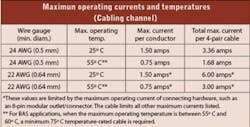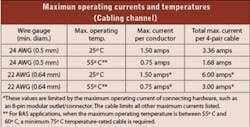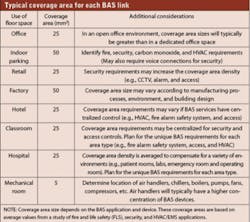Revision in the works for automated building standard
The first updates of the TIA/EIA-862 standard will maintain many elements of a structured cabling system.
Originally published in 2002, the Telecommunications Industry Association's (TIA; www.tiaonline.org) TIA/EIA-862 BAS Cabling Standard for Commercial Buildings establishes requirements for the cabling infrastructure that supports building automation systems (BAS). The standard's beginnings date back to the late 1990s when the original proposal was made for the TIA to establish a set of specifications for cabling systems that support BAS within and between buildings.
The standard specifies cabling requirements for cabling topology, architecture, design and installation practices, test procedures, and requirements for components that make up the cabling system. In October 2008, the TR-42.1 Subcommittee approved the project that will revise the 862 standard. Therevised standard will include support for new technologies, such as Internet Protocol (IP)-based BAS and BAS that are powered using Power over Ethernet Plus technology.
Additionally, the TIA's “Green Initiative,” which has been documented in this magazine and elsewhere, recommends the use of the TIA-862 standard to integrate telecommunications cabling and infrastructure for different services and improve building management.
Drivers of adoption
So, a full decade after the original proposal for a BAS cabling standard was made to the TIA, the standard has been published, is now in the early stages of a revision, and is poised to gain traction in an industry that has a newly raised consciousness of what BAS can deliver. Specifically, the growing trends of energy management and increased building security are drivers that bring the standard into focus for building owners and managers. Reports show that 50% of global energy consumption is used for building systems, including heating, ventilation, cooling, and other systems. The opportunity to reduce total energy consumption is enormous.
Several well-recognized players, including Cisco Systems, Johnson Controls, and Honeywell are aware of these statistics, see the opportunities available through BAS, and are taking action to position themselves to serve energy-management needs.
With that economic and social landscape as the backdrop, let's look a little more closely at some of the TIA-862 specifications as well as some changes that are under consideration for its revision.
The standard defines a number of wiring subsystems used to serve BAS—subsystems that are familiar to anyone who is versed in the TIA-568 series of cabling standards, including horizontal, riser/backbone, campus, and equipment-room subsystems.
The 862 standard also includes what it dubs the “coverage area” subsystem, which can be described as a work-area-type subsystem. A coverage area is defined as the area served by one system. For example, a heat sensor in a BAS serves one coverage area. This area of a BAS cabling system can, in several ways, vary from the more traditional 568-style system (described later).
The 862 standard will sound familiar in other ways as well. It requires that horizontal cabling for BAS meet the performance requirements of TIA/EIA-568-B.1. The recognized media are 100-O balanced twisted-pair cable, 50-µm and 62.5-µm multimode fiber-optic cable, and singlemode fiber-optic cable. All these media are referenced in the 568-B set of standard specifications. Additionally, associated connecting hardware, crossconnect jumpers, patch cords, and equipment cords shall comply with either TIA/EIA-568-B.2 or 568-B.3.
Cabling installation requirements under TIA-862 shall conform to 568-B.1 as well. Likewise, the sharing of pathways and spaces is permissible, subject to the limitations of applications and that which is allowable by local codes and regulations, as well as the authority having jurisdiction (AHJ).
Differences between the two standards do exist, however; for example, patch cords/jumpers are are limited to 5 meters (as opposed to the 10 meters allowed in 568-B). Also, sheath-sharing is permissible under the standard but is subject to the approval of the equipment vendor(s).
The current capacities of different copper cabling systems is also important, because in many BAS applications, sensors and actuators are powered through the copper cabling. Therefore, knowing the limitation of current sent through the cabling is important.
Topology topics
The TIA-862 standard calls for BAS cabling systems to be laid out in the familiar star topology, which allows for ease of instal-lation, diagnostics, and ongoing operations. The backbone cabling is a hierarchical star, basically the same as the 568 standard.
Centralized cabling is permitted, but may be subject to distance limitations for both fiber and copper media. In a BAS, the consolidation point used for zone distribution is called the horizontal connection point (HCP); it allows configurations near the zone and also permits crossconnections as opposed to limiting the topology to an interconnection.
The link and channel setups of BAS cabling systems are worth noting. A BAS cabling system includes a permanent link with a maximum 90-meter distance that reaches from the BAS patch panel/crossconnect in the telecommunications room to the HCP or BAS outlet. This portion of the cabling system is tested as a permanent link.
The channel, however, does not have an assigned maximum distance. Rather, the maximum allowable distance for a BAS channel is application-specific. This is where the coverage area subsystem, briefly described earlier, is worthy of closer examination.
Often, multiple BAS devices are daisy-chained outside the BAS outlet or HCP in what is described as an extended coverage area. As you are probably aware, daisy-chaining is not a recognized topology in the 568 set of standards. This extended-coverage area, including daisy-chained BAS devices, may be the most notable difference—with the most practical impact—between the 862 specifications and the 568 specifications.
Additionally, some BAS systems rely upon, and the 862 standard offers as options, other topologies—including bridged branches, chained branches, multipoint bus, multipoint ring, and multipoint bus with bridged connections. Here are brief descriptions of each optional topology:
- Bridged branches—Users can bridge up to 10 BAS devices together at the HCP. The bridge is formed using cables that bridge appearances on the connecting block.
- Chained branches—Connections go from one device to the HCP, then to a second device and back to the HCP, and so forth, up to a maximum of 10 BAS devices.
- Multipoint bus—A setup in which connections go from the HCP to multiple devices, up to a maximum of 10.
- Multipoint ring—Similar to the multipoint bus, except the final connection goes back to the BAS patch panel in the telecommunications room.
- Multipoint bus with bridged connections—A bridge is formed at the HCP, and each branch of the bridge has multiple BAS devices. This topology allows a maximum of 10 bridged branches and a maximum of five devices per branch.
The TIA-862 standard recognizes and allows these additional topologies because 862 is a practical set of specifications, and the reality is that these topologies are necessary to accommodate the needs of BAS devices. In the real world, this is how BAS systems are wired today, and the reality of current BAS technology had to be accommodated within the 862 standard.
As stated earlier, the 862 standard does not cap channel distance in the way the 568 standard caps it at 100 meters. The optional topologies described above, and other application-specific requirements that affect the coverage area subsystem, are the reason. With that in mind, the standard does include a table that describes typical coverage area, in square meters, for different environments. As shown in the table above, in many cases, the recommended or typical coverage area is 25 m2, but it can range from 5 to 50 m2.
Implement-friendly
The topology and architecture of BAS cabling systems spelled out in the TIA-862 standard are familiar, and even though the coverage-area subsystem may include new or different topologies, the cabling systems overall are relatively easy to understand, implement, and operate.
MASOOD SHARIFF is a member of the Systimax Labs staff with CommScope (www.commscope.com). He is a member of the Telecommunications Industry Association TR-42.1 Committee, which created and is revising the TIA/EIA-862 BAS Cabling Standard for Commercial Buildings.


